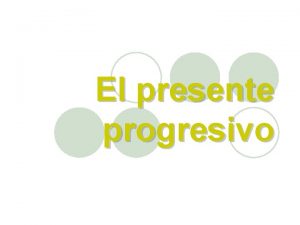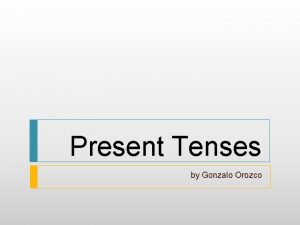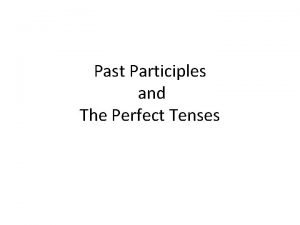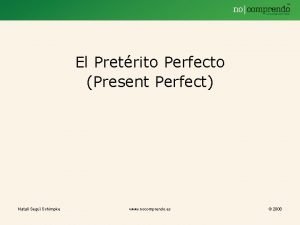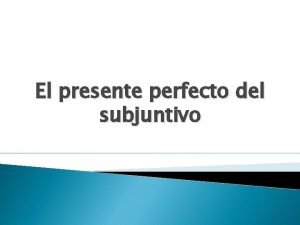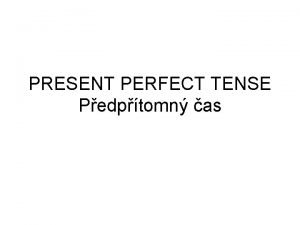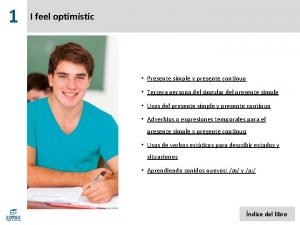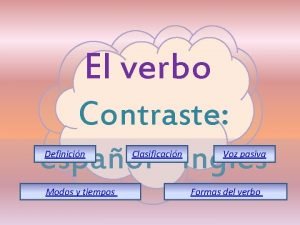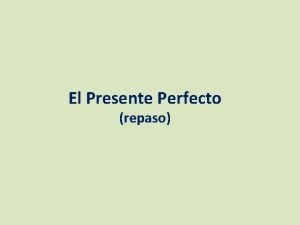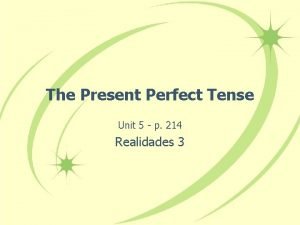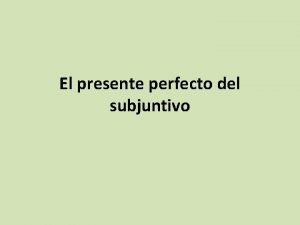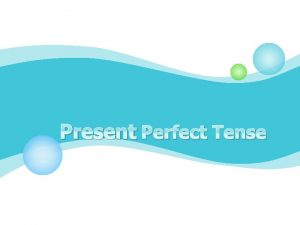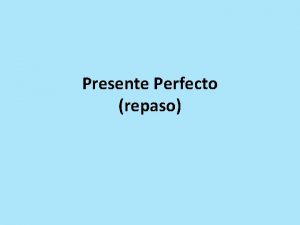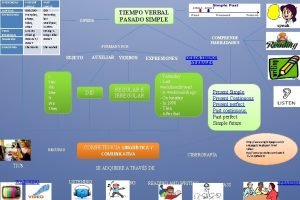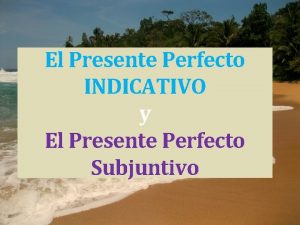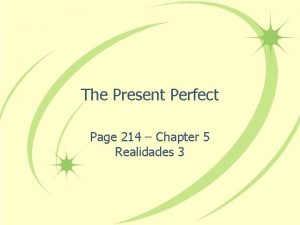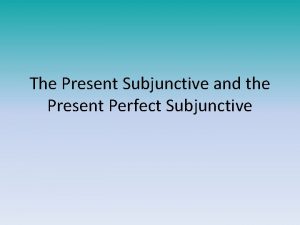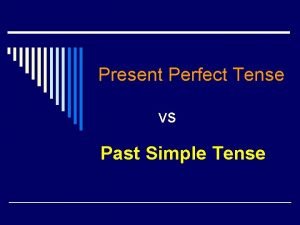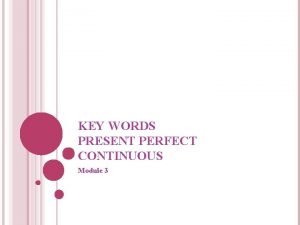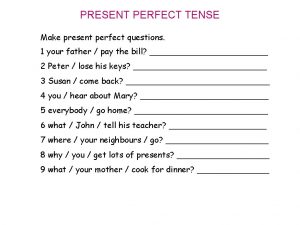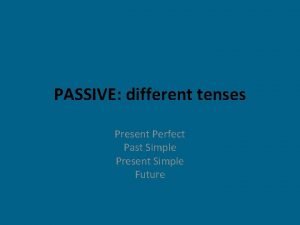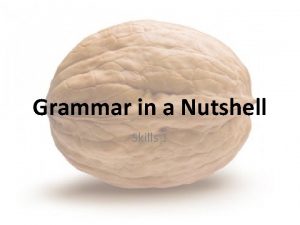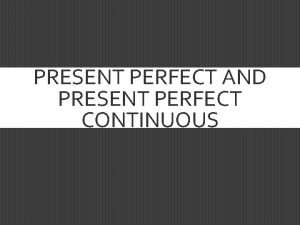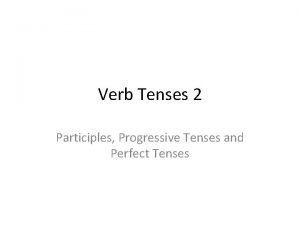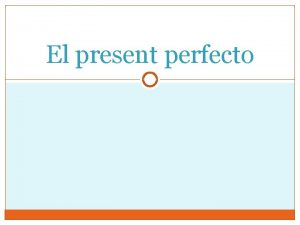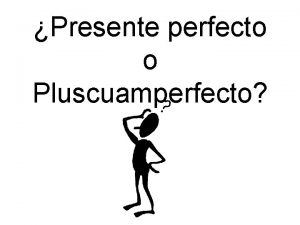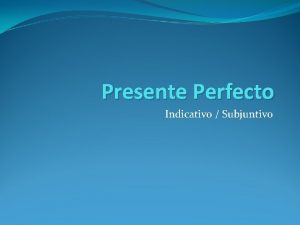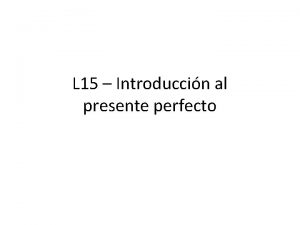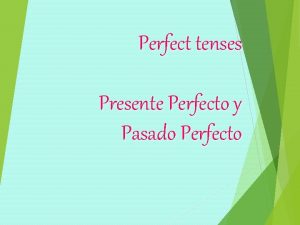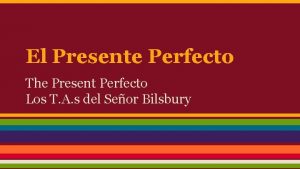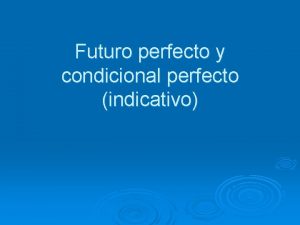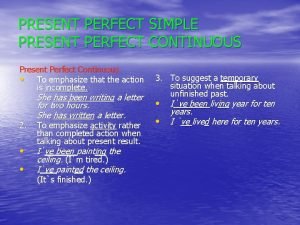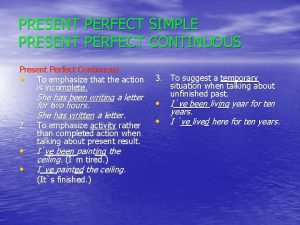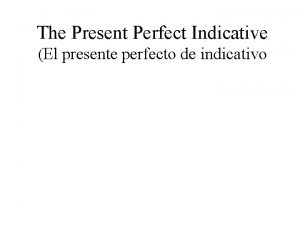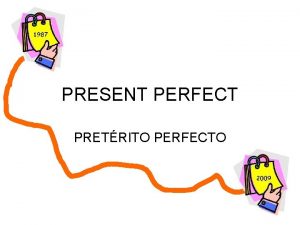Present Perfect El Presente Perfecto What is present














































- Slides: 46

Present Perfect El Presente Perfecto

What is present perfect tense? • The present perfect tense connects the present to the past. • It is used to express actions that happened at an unspecified time or that began in the past and continue in the present. The exact time is not important. • Present Perfect can’t be used with specific time expressions such as yesterday, one year ago, last week, etc. • Present Perfect can only use unspecific expressions such as: ever, never, already, yet, just, once, many times, several times, before, so far, etc.

Examples 1. I have seen that movie - Yo he visto esa película 2. We have lived in London - Hemos vivido en Londres 3. He has never been abroad - El nunca ha estado en el extranjero

The Presente Perfect El presente perfecto • Is frequently used for past actions “have” (o “have not”) happened” that continue into the present, or continue to affect the present. 1. He estado dos semanas en Madrid. I have been in Madrid for two weeks. 2. Diego ha sido mi amigo por veinte años. Diego has been my friend for 20 years.

Remember • You should not use this tense with time expressions like yesterday, a week ago, last year, etc. • Examples: – I have seen her yesterday – We have gone to California last year.

Present Perfect Uses • Life Experience: We often use the present perfect tense to talk about experience from the past, but we don’t say when the experience happened. • Examples: 1. She has lived in India. Ella ha vivido en la India 2. They have visited The Iguazu Waterfalls three times Ellos han visitado la cataratas del Iguazu tres veces 3. We have never seen that film Nosotros nunca hemos visto esa película

Present Perfect Uses • Finished action with a result or consequences in the present. – I have lost my credit card – He perdido my tarjeta de crédito – They have missed the bus - Ellos han perdido el autobús • Actions that change over time – I have bought a car. - He comprado un carro – You have grown since the last time I saw you • Has crecido desde la última vez que te vi. – My English has really improved • Mi Inglés ha mejorado considerablemente

Present Perfect Uses • Continuation in the present – The present perfect tense is used to talk about an action which started in the past and continuous up to now. • He has worked as a teacher for over 25 years – El ha trabajado como maestro por más de 25 años • She has achieved a lot in his life. – Ella ha alcanzado mucho en su vida • How long have you been at this website? – Hace cuanto que usted ha estado en este sitio web.

El Presente Perfecto

How is formed? Is formed by combining the auxiliary verb “has” or “have” (haber) with the past participle of the verb. – Yo he estudiado (I have studied)

PERSONAL PRONOUNS

Auxiliary Verb “Haber” • Auxiliary verb “haber” conjugation + Past Participle Singular Yo he Tú has Él, ella, usted ha Plural Nosotros (as) Vosotros (as) Ellos, ellas, ustedes hemos habéis han

“El participio pasado” (Past Participle) • In the regular verbs: Drop the infinitive form from the verb and add the ending – Los verbos de –ar -ado (hablar hablado) – Los verbos de –er y –ir -ido (vivir vivido) – Los acentos son necesarios para el verbo oír, reír y los verbos de –aer (traer, caer, ) y –eer (leer, creer) = ído • Remember, some past participles are irregular and the doesn’t follow the same pattern and you have to memorize them.

Haber + El Participio Pasado = El Presente Perfecto (del indicativo) ¿¡¿Más gramática? !? The auxiliary verb and the past participle are never separated.

¿Has estudiado para el examen de química? No, pero he estudiado para el examen de algebra Ana, ¿has añadido todos los ingredientes? Si mamá, he añadido los huevos y la harina.

El presente perfecto with the “ya” (already) expression • The present perfect tense is often used with the verb “ya” (already) – Ya han comido • They have already eaten – La empleada ya ha limpiado la casa • The maid has already cleaned the house

Present Perfect in Negative Sentences • To make the sentence negative, add the word “no” before the conjugated form of haber. – (yo) No he comido (I have not eaten) – (tú) No has comido (you have not eaten)

El presente perfecto with DOP’s • Again, the auxiliary verb and the past participle are never separated. • Object pronouns are placed immediately before the auxiliary verb. – Pablo le ha dado mucho dinero a su hermana. (Pablo has given a lot of money to his sister) – Pablo no le ha dado mucho dinero a su hermana. (Pablo has given a lot of money to his sister)

El presente perfecto con pronombres reflexivos (Reflexive Verbs) • The reflexive verb is placed immediately before the auxiliary verb. • Compare how the present perfect differs from the simple present, when a reflexive verb is used. – Present Tense: • Me cepillo los dientes (I brush my teeth) – Present Perfect: • Me he cepillado los dientes (I have brushed my teeth) – Negative Sentence: • No me he cepillado los dientes. (I have not brushed my teeth)

Present Perfect in Questions • Questions are formed as follows. – In affirmative way with questions marks ¿? – The auxiliary must be written first? • ¿Has probado el chocolate alguna vez? Haven’t you ever tried chocolate? • ¿Han salido ya las mujeres? Have the women left yet?

PRESENT PERFECT IRREGULAR VERBS 1. decir – to tell (dicho) 2. hacer – to do, to make (hecho) 3. abrir – to open (abierto) 4. cubrir – to cover (cubierto) 5. poner - to put (puesto) 6. volver – to return (vuelto) 7. resolver - to solve (resuelto) 8. escribir – to write (escrito) 9. ver – to see (visto) 10. morir – to die (muerto) 11. romper – to break (roto) 12. imprimir – to print (impreso) 13. ser – to be (sido) 14. ir – to go (ido)

Practice • Exercises (click here) • High Frequency verbs (click here) • Quiz (click here)

Practice Write in full senteces using the present perfect. Conjugate the infinitive verb. 1. Mi madre/cocinar/cena/sabrosa. Mi madre ha cocinado una cena sabrosa. 2. Nosotros/comer/postres/rico/aquel/mesa. Hemos comido postres ricos en aquella mesa. 3. El camarero/servir/almuerzo. El camarero ha servido el almuerzo. 4. Margarita y Marcos/hacer/dos/entremés/delicioso. Margarita y Marcos han hecho dos entremeses deliciosos. 5. “¿Carlitos/imprimir/invitaciones? ” “¿Carlitos, has impreso las invitaciones? ”

Translate - Traduce 1. I have seen that movie twenty times. 2. There have been many earthquakes in California. 3. People have traveled to the Moon. 4. People have not traveled to Mars. 5. Have you read the book yet? 6. Nobody has ever climbed that mountain. 7 A. Has there ever been a war in the United States? B: Yes, there has been a war in the United States 1. He visto esa película veinte veces. 2. Ha habido muchos terremotos en California. 3. La gente ha viajado a la luna. 4. La gente que no han viajado a Marte. 5. ¿Ya has leído el libro? ¿Has leído ya el libro? 6. Ninguna persona ha escalado a esa montaña 7. A: ¿Ha habido una guerra en los Estados Unidos? B: sí, ha habido una guerra en los Estados Unidos

Una Comparación con el Pretérito • Presta atención a la diferencia: a) Corrí por el Parque Hartshorne ayer. (I ran through Hartshorne Park yesterday. ) b) He corrido tres veces esta semana. (I have run three times this week. )

Present Perfect – Presente Perfecto and Past Perfect - (Pluperfect) Pluscuamperfecto


Past Participle All perfect tenses are made up of two parts: the auxiliary verb (helping verb) and the past participle of the main verb: helping verb past participle He has eaten. They have left. I have studied. helping verb past participle We have seen. You have finished. She has fallen.

This is how you form the past participle in Spanish: Drop the –ar and add –ado: hablar pensar llegar hablado pensado llegado nadar almorzar estar nadado almorzado estado Drop the –er or –ir and add –ido: comer leer asistir comido leído asistido poder querer venir podido querido venido

There are, of course, irregular past participles in Spanish as there are in English. call jump look eat bring have called have jumped - ha have looked have eaten have brought

You have to memorize the irregular past participles in Spanish just as you do in English. volver poner abrir cubrir escribir ver morir decir hacer romper vuelto puesto abierto. cubierto escrito visto muerto dicho hecho roto

Auxiliary Verbs Helping Verb Now you need a helping verb to go with your past participles. What we use is the present tense of the verb “haber. ” he hablado has hablado ha hablado hemos hablado habéis hablado han hablado Use these verb forms with all your past participles: he comido, has querido, ha vuelto, hemos trabajado, etc.

Pluscuamperfecto (Pluperfect) Past Perfect

Pluperfect (Past Perfect) (Pluscuamperfecto) The past perfect (also called the pluperfect and, in Spanish, the pluscuamperfecto), remember, is the past of the past and translates with “had” in English. ALL perfect tenses get a helping verb and a past participle: present perfect past perfect future perfect conditional perfect he has eaten he had eaten he will have eaten he would have eaten


As you saw, the present perfect tense has a set of helping verbs that come from “haber”: he has ha hemos habéis han The same is true of the past perfect. The helping verbs for the past perfect are the imperfect form of “haber”: había hablado habías hablado habíamos hablado habíais hablado habían hablado

Note that the endings on “haber” for the past perfect are the endings for the imperfect tense: habías habíamos habíais habían The present perfect is the PRESENT tense of “haber” + the past participle. The past perfect tense is the IMPERFECT (PAST) tense of “haber” + the past participle.

El Pluscuamperfecto Pluperfect Uses • You use the pluperfect tense to describe an action in the past that occurred before another action in the past. • The more recent past action typically signals the end of the previous past action, as in the following examples: – Nosotros habíamos terminado con la cena antes de que ellos llegaran. We had finished dinner before they arrived. – Ella nos había llamado antes de visitarnos. She had called us before visiting us. – Yo me había acostado después de mi programa favorito. I had gone to bed after my favorite program.

Before the rescue, I had built a shelter from palms and sticks


Pluscuamperfecto Auxiliary Verb “Haber” • To form the pluperfect, combine the imperfect tense of the verb “haber” with a past participle Singular Yo había Tú habías Él, ella, usted había Plural Nosotros habíamos (as) Vosotros habíais (as) Ellos, habían ellas, ustedes

Present Perfect Vs. Pluperfect Presente Perfect tense El presente perfecto Pluperfect (Pluscuamperfecto) • • Presente Haber + Past Participle – has – ha – hemos – habéis – han Imperfecto Haber + Past Participle – habías – habíamos – habíais – habían

Pluscuamperfecto • To form the pluperfect tense, combine the imperfect tense of the verb “haber” with a “past participle” Haber – habías – habíamos – habíais – habían + Past participle - hablar hablado hablado

Pluscuamperfecto Exercises • Click here • Or type the following URL: https: //espanol. lingolia. com/en/grammar/te nses/preterito-pluscuamperfecto/exercises • Write this exercises in your journal or play on line.

Irregular Verbs (Memorize them) Presente Perfecto/Pluscuamperfecto 1. decir – to tell (dicho) 2. hacer – to do, to make (hecho) 3. abrir – to open (abierto) 4. cubrir – to cover (cubierto) 5. poner - to put (puesto) 6. volver – to return (vuelto) 7. resolver - to solve (resuelto) 8. escribir – to write (escrito) 9. ver – to see (visto) 10. morir – to die (muerto) 11. romper – to break (roto) 12. imprimir – to print (impreso) 13. ser – to be (sido) 14. ir – to go (ido) 15. descubrir- to discover (descubierto) 16. Satisfacer – to satisfy (satisfecho) 17. Contradecir – to contradict (contradicho)

Pluscumperfecto Vs. Present Perfect • Quiz - Click here (to practice) • Or type: Or type the following URL: http: //www. trinity. edu/mstroud/grammar/perf ect. htm * Complete your quiz in the paper
 Yo no soy perfecto
Yo no soy perfecto Presente progresivo comer
Presente progresivo comer Presente perfecto
Presente perfecto Presente perfecto
Presente perfecto Presente perfecto pasivo
Presente perfecto pasivo Haber presente perfecto
Haber presente perfecto Presente perfecto spanish
Presente perfecto spanish El presente perfecto del subjuntivo
El presente perfecto del subjuntivo Pasado participio
Pasado participio Presente perfecto
Presente perfecto Diferencias entre pasado simple y presente perfecto
Diferencias entre pasado simple y presente perfecto Interrogativo en presente continuo
Interrogativo en presente continuo Voz pasiva y voz activa
Voz pasiva y voz activa Dormir en presente perfecto
Dormir en presente perfecto Present perfect have has
Present perfect have has Oraciones en presente perfecto
Oraciones en presente perfecto Ride present perfect
Ride present perfect Entrevista en presente perfecto
Entrevista en presente perfecto Presente perfecto endings
Presente perfecto endings Tiempo verbal
Tiempo verbal Presente perfecto indicativo
Presente perfecto indicativo Caer present perfect
Caer present perfect Diferencia entre presente simple y pasado simple
Diferencia entre presente simple y pasado simple Present perfect reglas
Present perfect reglas Present perfect auxiliary verb
Present perfect auxiliary verb Estructura past participle
Estructura past participle Verbo to be present perfect
Verbo to be present perfect Present perfect tense vs present perfect continuous tense
Present perfect tense vs present perfect continuous tense When to use present perfect subjunctive
When to use present perfect subjunctive Book present perfect
Book present perfect Present perfet
Present perfet Past simple present perfect present perfect continuous
Past simple present perfect present perfect continuous Present perfect present perfect continuous past simple
Present perfect present perfect continuous past simple Present perfect vs present perfect continuous
Present perfect vs present perfect continuous Key words of present perfect continuous
Key words of present perfect continuous Run present perfect
Run present perfect Make in the present
Make in the present Ejemplos de past simple y past perfect
Ejemplos de past simple y past perfect Present perfect simple present perfect progressive
Present perfect simple present perfect progressive 10 examples of present perfect continuous tense
10 examples of present perfect continuous tense Present perfect present perfect continuous exercises
Present perfect present perfect continuous exercises Past perfect spanish examples
Past perfect spanish examples Difference between present perfect simple and continuous
Difference between present perfect simple and continuous Be presente progresivo
Be presente progresivo No recibiras presente porque el presente ciega
No recibiras presente porque el presente ciega Present simple present continuous and present perfect
Present simple present continuous and present perfect Which verb tenses describe continuing action?
Which verb tenses describe continuing action?

